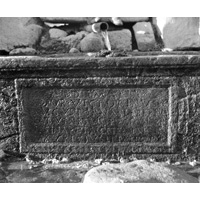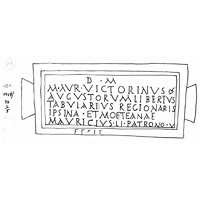 MAMA XI 176 (Prymnessos)
MAMA XI 176 (Prymnessos) 
Fragment of a building inscription
- Type of monument:
- Bilingual funerary inscription.
- Location:
- Süğlün (Prymnessos): re-used as a horse-trough in a fountain (Güvercinlik Çeşmesi) at the south end of the village.
- Description:
- Pink trachyte sarcophagus with upper moulding, buried below. On one side, tabula ansata. Lines 1-6 of inscription within the tabula ansata, line 7 on lower rim, line 8 below.
- Dimensions:
- Ht. 0.57+; W. 2.07; Th. 0.83; tabula ansata, Ht. 0.40; W. 0.82; letters 0.030-0.040.
- Record:
- Line drawing; MB notebook copy; photograph (1955/74).
- Publication:
- Ballance 1969; (BE 1972, 456; AE 1973, 533; Kearsley 2001: nο. 110).
- Date:
- Late second or early third century AD.
hed. dd(is) m(anibus)
M(arcus) · Aur(elius) · Victorinus hed.
Augustorum libertus
tabular⟨i⟩us regionaris
5 Ipsina⟨e⟩ · et Moeteanae
Mauricius li(bertus) · patrono hed.
fecit arc̣am tanṭum
Τ(ίτος) Στά⟨τ⟩ιος Νίγερ συνεχώ̣ρησα τὴν σορὸν ἐπιτεθῆναι φιλίας χάριν
Line 4: TABULARTUS lapis. Lines 6-7: M. Aur. Icius li(bertus) patrono v(otum?) | fecit arẹam tanṭum Ballance 1969.
Line 8: Στάσιος Ballance.
To the spirits of the dead. M(arcus) Aur(elius) Victorinus, freedman of the Augusti, tabularius of the regio Ipsina et Moeteana. His freedman Mauricius made this sarcophagus for his patron alone (?). T(itus) Sta⟨t⟩ius (?) Niger granted that the sarcophagus should be placed (here), for friendship’s sake.





Ballance reported (1969: 143-4) that ‘the stone was covered with moss and dripping with water; in the circumstances it was impossible to make an impression’. His photograph, ‘taken just before sunset’, illustrates lines 1-6 only; ‘further scrubbing then revealed lines 7-8, the former on the border of the tabula, the latter below it; it was too dark for a second photograph’. The readings in lines 7-8 thus depend solely on Ballance’s notebook copy, with the exception of the first word of line 7 (fecit), which can just be made out on the photograph.
At the end of line 6, Ballance misread the lower part of a hedera as the letter V, which he understood to be an abbreviation of v(otum). In line 7, Ballance read fecit arẹam tanṭum; the term area is out of place here, and I suspect that the true reading is arc̣am, ‘funerary chest, sarcophagus’, corresponding to σορόν in line 8. If the word tantum is correctly read, it ought to mean that the arca was ‘for him only’: cf. Hagel and Tomaschitz 1998: 378, SlT 2 (C. Iulius Celer... sibi et Iuliae Primillae co(niugi) b(ene) m(erenti) fecit posterisque suis tantum). In line 6, Ballance hesitated as to whether to interpret the letters MAVRICIVS (without interpuncts) as M. Aur. Icius or Mauricius (1969: 144). The name Icius is very poorly attested (apparently only in I.Smyrna 223, τὸ μνημεῖον ἐστιν Ἰκίου Ἰκίου τοῦ Εὐημέρου; the Roman gentilician Iccius is not relevant), and it is probably better to suppose that Victorinus’ freedman carried the name Mauricius. In line 8, Ballance read the personal name as Τ. Στάσιος Νίγερ. However, the gentilician Stasius seems to be otherwise unknown; I have assumed a minor misreading of the common gentilician Στά⟨τ⟩ιος (a T. Statius is attested at Ephesos: I.Ephesos 47.98).
For the freedmen tabularii of imperial estates, see Weaver 1972: 244-52; the evidence for imperial freedmen acting as tabularii for imperial domains in eastern Phrygia is collected by Drew-Bear 1978: 10-12. The title tabularius regionarius (= tabularius regionis) seems not to be attested elsewhere, although soldiers deputed to the protection of particular provincial districts were regularly known as regionarii (Brélaz 2005: 264-7); cf. e.g. the centurio regionarius (ἑκατόνταρχον ῥεγεωνάριον) at Pisidian Antioch (Calder 1912b: 80-4; Roueché 1981: 115-16). For the use of the term regio to refer to imperial estates in Asia Minor, cf. TAM V 3, 1871 (Philadelpheia: βοηθὸς ἐπιτρόπων ῥεγιῶνος Φιλαδελφηνῆς); IGR III 1502 (Oinoanda: ῥεγεῶνος Οἰνο(ανδικῆς)); Drew-Bear and Naour 1990: 1967-80.
For this particular cluster of imperial estates, situated in the Upper Tembris and Kaystros valleys north of Prymnessos, see Strubbe 1975: 230-6. The eponymous centre of the regio Moeteana has not been located with precision; Ballance 1969: 146 plausibly connected the name with the δήμου κοινο⟨ῦ⟩ Μοιτεανῶν Σοηνῶν, part of a group of inhabitants of this imperial estate who submitted a petition to Philip the Arab in AD 244-6 (MAMA X 114.8; Hauken 1998: 140-61, esp. 154-5). The village of the Μοιτεανοί ought therefore to lie in the vicinity of the village of Soa, securely located at modern Altıntaş Köyü in the Upper Tembris region (TIB Phrygien 385-6, s.v. Soa). On the regio Ipsina and the location of Ipsos (the site of the defeat of Antigonos Monophthalmos in 301 BC), see Robert, Hellenica VII, 215-9; Strubbe 1975: 236-9; TIB Phrygien 282, s.v. Ipsos.